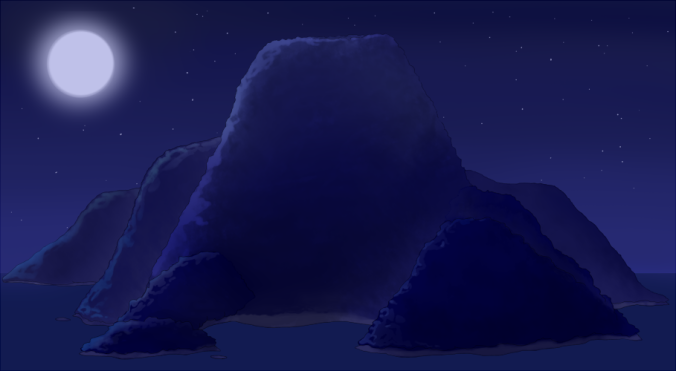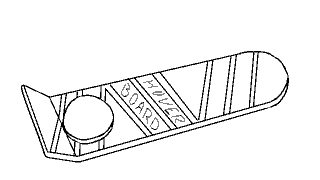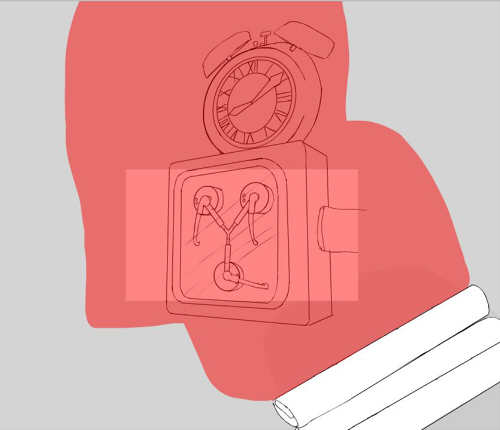Tidal wave of blog posts incoming! Really should have done this earlier, whoopsies. Lets see how much I can remember.
The rapid project for this trimester was to create a short teaser trailer for a classic video game. As usual we had a time budget of 10 hours a week as well as randomly generated specifications. Our group generated the games Jazz Jackrabbit and Monkey Island and the teaser styles Environment fly through and music video. In hindsight we really should have asked for another roll on the game choices as none of us were familiar with either of those games, but we ended up deciding on Monkey Island in an environmental fly through style.

It was decided pretty early that we would do the project in 2D seeing as most of the team said they were more competent with drawing than modeling. Our initial plan was to make flat illustrations and zoom out through the various scenes, starting in a building and then resolving with a wide shot of the Island. I made some rough color keys/environment concepts after doing some research into the locations in the game.

The Jail on Melee Island

Outside the jail with the church to the right

Shot of the whole of Melee island
We pitched this idea and provided a storyboard and received some criticism that our teaser wouldn’t be capturing the essence of the original Monkey Island game, which I agreed with and really should have pushed my team more to take it into consideration. I think as a team we really needed to become more familiar with game as a whole instead of just jumping to conclusions about what it was about, which definitely isn’t the right way to appeal to fans of the series and create an effective trailer. (ANM220.LO19: Work objectively towards a common goal by giving constructive criticism and applying feedback, ANM220.LO12 Evaluate the effectiveness of production processes undertaken)
I was asked to create a vertical slice quite early in the project to show what the final project would look like.

I made sure apply some visual fundamentals with this piece as it was supposed to represent the final quality of the project! Colour theory, lighting and values were things I relied on to keep the illustration interesting as the jail was quite dull, composed entirely of browns and blacks, so I made sure to have enough contrast between all those things, like the blue shadows and the orange of the firelight. There’s no fire in the scene because it was going to be added in after effects. (ANM220.LO10 Combine elements with consideration of visual fundamentals to produce aesthetically cohesive work)
I made sure to keep the image size large because the camera would be zooming through the image and if I didn’t you would likely see pixels in the final product. I was also asked to keep different elements on separate layers in case they needed to be animated in after effects to create a better sense of the camera moving through the illustration. (ANM220.LO.11 Output work that conforms to technical specifications required for the chosen medium)
We had a change in the production method about halfway through our project, which required a few of the assets we had already done to be heavily modified and ended up increasing the workload for a few team members. We were asked to separate the background we had already done into separate images and remove any lighting we had painted in so the environment could be built in 3D in after effects using cards and have the lighting applied in there. I really should have shared my thoughts on it more as I felt it was a bit of a risk so late in the project and took some of control I had over what my art looked like in the final product away.
So I split up and reduced the lighting I had done in the jail scene. All our assets were kept convieniently on Google Drive And we communicated on Slack, though we would have benefited a lot more from more exhaustive documentation and a more fleshed out assets list, which I really should have helped out with. (ANM220.LO17 Implement & maintain technical frameworks that allow for collaborative production)

Here are the rest of the assets I made for the project!



And the final product in which we asked some audio students to create a backing track to fit the video. It turned out they had a few issues we had no idea about, so we probably should have prompted them to communicate more or added the to our slack. (ANM220.LO02 Effectively integrate sound with animation.)
I’m not entirely happy with the final product but we did get in on time and to the brief’s specification, that being a teaser of our designated game and style that was between 15-30 seconds.
(ANM220.LO15 Produce work on time and within scope by engaging appropriate project management methodologies)
(ANM220.LO16 Operate in a production environment to conceive, create, and implement creative productions)
(ANM220.LO18 Interpret a brief and deliver a product to a client’s specification)






















 My group was assigned the film Back to the Future and the style of title sequence we are drawing from is the trailer for Typomad (Madrid Typography Festival.) The trailer is rather minimalist- relying on flat colours, simple shapes and patterns, animations and panning to reveal the initials of important people attending the event, so it was interesting to see how we could apply this to BttF and still make it interesting and recognizable.
My group was assigned the film Back to the Future and the style of title sequence we are drawing from is the trailer for Typomad (Madrid Typography Festival.) The trailer is rather minimalist- relying on flat colours, simple shapes and patterns, animations and panning to reveal the initials of important people attending the event, so it was interesting to see how we could apply this to BttF and still make it interesting and recognizable.

